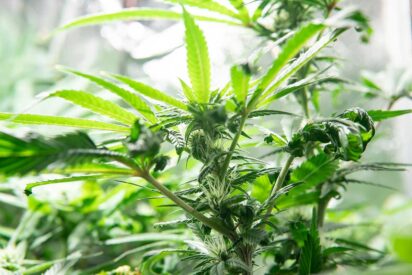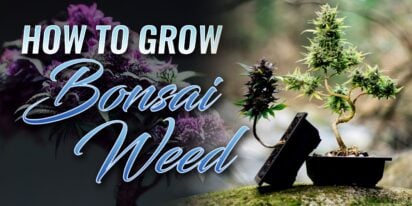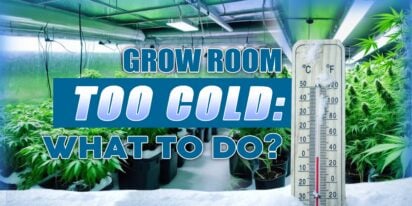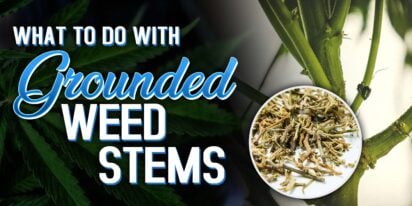
Are You 18 Or Over?
YesOr
No By clicking yes, you certify that you are over 18. By using this website, you agree to our legal disclaimer.605+ Cannabis Strains over 20 Breeders worldwide.
Table of Contents

Growing your own cannabis is not as easy as most would think, even if there are strains out there recommended for beginners. Cannabis plants need the utmost attention and care for them to thrive, just like us human beings. All strains will share similarities on how you can raise them, but can also have some distinct needs that set them apart from other types of weed. Cannabis may experience cannabis leaves curling up that should be diagnosed and fixed early.
To ensure the overall health of your plant, growers are always advised to keep an eye out on one part that can alert you right away: the leaves. Leaves will often reflect how certain conditions affect it through physical changes. A common problem encountered with cannabis plants is curly leaves.
While this is not a good look, it is also a sign that there could be one or several factors that may be affecting the plant’s health, thus further hindering it from growing if not treated the right way. But there is still hope! You can still save your plant and get it back on track towards a potent yield by learning about the causes of curled up leaves and how you can fix them.
Some cannabis plants favor warm climates, while other strains will prefer cooler climates. Though if cannabis is left in extremely warm or cold conditions, they start to darken and curl or claw in from the edges. These extreme temperatures will halt them from photosynthesis; hence it will disrupt their growth.
Curling from high heat or cool settings are not only experienced outdoors but in indoor gardens as well if you do not set the right temperature. While cooler temperatures are needed to encourage flowering, if you set the temp too low, it can actually kill off the leaves and worse, dull, lifeless buds.
To fix cannabis leaves curling up, follow these tips: For plants exposed to warmer temperatures, if kept indoors, check your heater settings and adjust it to about 26 to 28 degrees Celsius (or lower than the previous temperature it was exposed to). You may also set a fan next to it to promote air circulation and help it cool off from the warmth. Plants grown outdoors should be moved to a shaded area or have a screen installed overhead.
If your plant has been growing under cooler temperatures, the best solution is to install lamps. A lamp should give it enough warmth without taking away the amount of light it needs. You may also adjust your heater to the recommended 28 degrees Celsius to warm up your plant again.
Cannabis will not be able to call you out when they start feeling thirsty, and signs that it’s time to water them may not be that obvious. We often tend to overwater our plants in fear that they dry up fast and need it almost daily. Too much water will drown the roots and cause them to rot, molds, and mildew will start showing up, and those curled leaves will soon get your attention. This is the common plant killer since we tend to think water sustains them the most, but too much of it is actually unhealthy.
Make sure your plant is getting the right amount of light and warmth, which helps it absorb water faster. Let the water dry up completely before watering again, or the pit can make the rotting worse, which is the most difficult to spot. You can know when your plant is dry and ready for another refreshment by lifting the pot: a lightweight pot means it is time to water, and a heavy pot means you should save the water for later. If you grow your cannabis outdoors, feel the soil. Tap the top surface, then poke a finger or a stick into the soil about a few inches deep, then pull it out. If you come out clean, your plant is ready for watering, but if a lot of soil sticks to you, refrain from watering for the meantime until you get a clean poke.
Just like watering, we also tend to use too much fertilizer on our plants with the idea that they will grow faster and appear healthier. Each strain may react to different kinds of fertilizer differently and cause discolored curly leaves. Fertilizers will usually combine nutrients and other chemicals as a supplement. In high doses, this can be harmful to the plant that can prevent it from growing further.
Stop using the current fertilizer you have and check if it has the recommended amount of Nitrogen, Phosphorus, and Potassium – each of these nutrients should go from highest to lowest, respectively (Nitrogen with the most, and Potassium with the least content). Read the label about its pH level, which should be measured at 6.0. If your current fertilizer does not meet these standards, switch it to a different one that contains all the right amounts. Follow the grow chart to be guided by how much fertilizer you should apply, and when is the best time.
The natural soil you plant grows in plus water might not be enough to sustain it. While this should be an organic approach, experts always advise techniques and supplements for your plant to grow with optimum results. Using fertilizers can go a long way with your cannabis for those big potent buds as long as they have the proper application and dose.
Choose a fertilizer with the standard amount of Nitrogen, Phosphorus, and Potassium, plus the average pH level for soil fertilizer. Apply this as directed on its grow chart and start with smaller amounts, slowly adding up as your plant adjusts to it and shows results. Stick to the prescribed amount of fertilizer and do not go overboard with it. A little can do so much more and save you from a lot of stress and worry. An overdose of fertilizer is not as easy to fix compared to a plant that lacks enough fertilizer.
Plant problems like cannabis leave curling up can be hard to avoid, whether you have zero experience or have been raising cannabis long enough. Curled cannabis leaves are a common concern that makes most growers think their plant is a lost cause. Extreme heat or cold temperatures, overwatering, using too much fertilizer, and existing nutrient deficiencies in the plant can be reasons for your cannabis to not be in its best shape. However, this can all be fixed with easy solutions. By being informed about why curling can happen, you can prevent making mistakes and take the right steps for your cannabis to grow back into its happy and healthy self so that you can be a proud plant parent and satisfied user as well.

In recent years, the discourse surrounding secondhand marijuana smoke has gained significant attention, paralleling the legalization and increas

In the realm of cannabis culture, the practice of "wake and bake" holds a significant place, accompanied by both supporters and skeptics. As exp

Introducing the robust indica strain known as Critical Mass weed, a harmonious fusion of Afghani and Skunk #1 genetics. Delve into its essence,

Fusarium wilt cannabis represents a significant threat to cannabis cultivation, necessitating a comprehensive understanding of its intricacies.

1980s were a time of profound cultural transformation, marked by iconic fashion, music, and movies. Alongside these trends, a unique facet of '8

[ez-toc] In the deep history of cannabis cultivation, there exists a captivating and creative practice that combines the art of cultivation wit

For growers looking to get better yields and healthier cannabis plants, it's important to understand and control the cannabis soil pH levels. pH

[ez-toc] In indoor gardening, maintaining an optimal temperature within your grow tent is crucial for the health and productivity of your plant

[ez-toc] Welcome to the delightful world of cannafudge crafting, where sweetness meets sophistication, and cannabis infusion adds a unique twis

[ez-toc] You’ve finished trimming your weed, but what about those leftover stems? Don’t throw them away! These seemingly useless bits can a

Are You 18 Or Over?
YesOr
No By clicking yes, you certify that you are over 18. By using this website, you agree to our legal disclaimer.